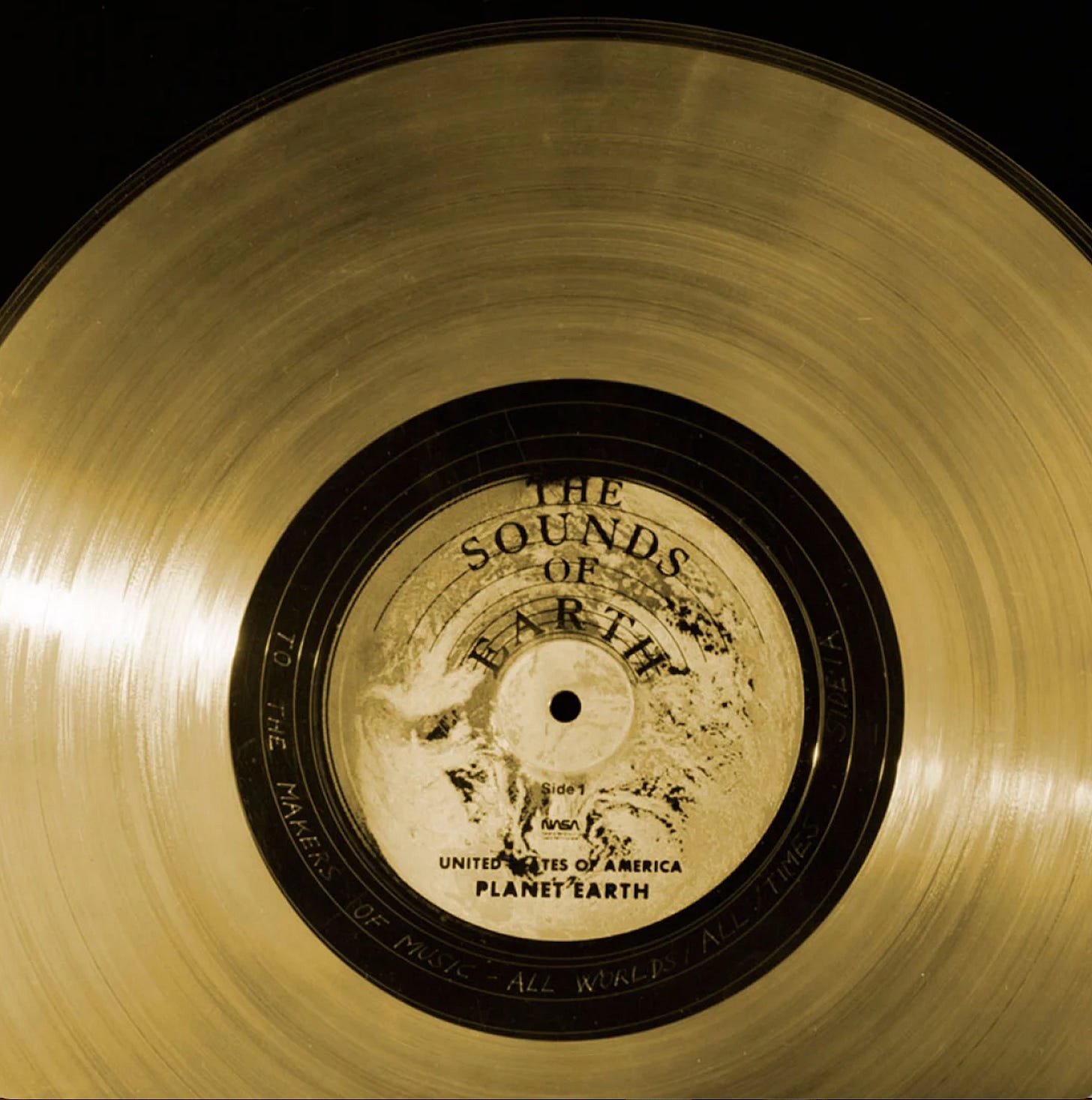an aggregate of joy
On the Golden Record, human capacity for hope, and the physical act of touching the heavens.
In 1977, NASA launched two probes into space, Voyager 1 and 2. Hurtling at 35,000 miles an hour, they are still exploring and sending back photos from the outer limits of what we have seen and known from our pale blue dot Earth. It was decided that it would be a missed opportunity if we were not to represent ourselves in some form or fashion on these moving metal masses. And it would further be a mistake to represent our world only with shop talk. So people sat and thought about what might best show a reduced version of us and our world.
Because music is mathematical and therefore universal, as well as an expression of the emotional human experience, it made the most sense to include some songs and sounds of our planet. It also happened to be the 100th year since the invention of the record, so the team in charge of figuring out how to imprint a bit of soul onto the machine called up the head of RCA records to help. Carl Sagan was the head of the group and he called in the help of Alan Lomax, Ann Druyan, Robert Brown, The United Nations, Jimmy Carter, and many others. A copper record was pressed with 90 minutes of music, as well as 117 pictures, greetings in 54 different languages, and hints and clues on who we are and what we do and think.
B.M. Oliver, vice-president for research and development at Hewlett-Packard at the time, summed up a part of the feel by saying “There is only an infinitesimal chance that the plaque will ever be seen by a single extraterrestrial, but it will certainly be seen by billions of terrestrials. Its real function, therefore, is to appeal to and expand the human spirit, and to make contact with extraterrestrial intelligence a welcome expectation of mankind.”
They were murmurs of Earth pulled from the greatest mixtape of a time and place. You might notice melancholy in the mix, and that is intentional. Even traveling at 35,000 miles per hour, it will still take them 40,000 years to pass near another star, and long after we are gone, this copper avatar will be preserved, out there, in the ether, with the words hand written around the run-out: “To the makers of music, all worlds, all times.”
Below is 42 minutes from the Golden Record edited for a fictional radio show I created for my work in trip planning…if your keen on a dive.
A little over ten years after the launch of Voyager 1 an opportunity presented itself and Carl Sagan took to action. Carl was an astronomer and planetary scientist by profession, but he was also a hidden poet who used physics and science as his language. He understood hope, love, and the human spirit and pushed for these things to be included in space exploration, in a time when a lot of that science was processed and militarized. It is why he insisted on the Golden record in the first place. Voyager 1 was moving across the universe, taking photos of Jupiter and Saturn and sending them back to the Jet Propulsion Laboratory in Houston Texas. Sagan noticed there would be a moment, although brief, when the Voyager would be in direct alignment with the earth, four billion miles away, and it would be a chance to see a view of Earth in a way humans had never been able to experience. This idea would necessitate a repositioning of the crafts camera which would take six months of programming work and millions of dollars. It was an act of politic, the conversations and questions and probing that Sagan went through, but he finally was able to get approval shortly before he was set to retire, a last poetic move in a career with NASA.
There was precedent for impactful photos of the planet. In 1968, astronaut William Anders took a photo of Earth from the moon, the first of its kind. The photo became known as “Earth Rise” and some would argue that through the perspective of this photograph, the idea of oneness and fragility entered into the international psyche. There were no ministries of the environment, no Earth Day, no environmental activism prior to that photo. It shifted the paradigm.
In a dark office on valentines day in 1990, Dr. Candice Hansen-Koharcheck zoomed in on the data coming into the feed in Houston and was the first to see what was to become called The Pale Blue Dot. There, in a stream of light and dust, a small spec: "It was just a little dot, about two pixels big" Hansen-Koharcheck has said. A reflection off the spacecraft made it look as though the speck was being lit up and held by a column of light. "You know, I still get chills down my back," says Hansen-Koharcheck. "Because here was our planet, bathed in this ray of light, and it just looked incredibly special."
The photos from the Voyagers Journey had been displayed in the Jet Propulsion Lab headquarters, there was a wall in the front foyer where they would be hung for all to see. The Pale Blue Dot photo went up and the strangest thing began to happen. Every few weeks they would have to reprint and replace the photo, it would smear and smudge, the little dot, the Earth from far away. For a long while no one knew what was happening until one day it was observed that the scientists, the people dedicated to the study of space, and time, and physics, walking in to work each day in the hustle and bustle of routine and coffee and traffic, would almost subconsciously or uncontrollably, reach up and touch the Earth in the photo, as if grounding the abstract for a brief moment. A tiny reaffirming action, over and over like little wee sistine chapel ceilings being acted out, a poetic simplicity in wanting to reach out and allow our physical selves to connect; primal and loving and earnest.
“Look again at that dot. That's here. That's home. That's us. On it everyone you love, everyone you know, everyone you ever heard of, every human being who ever was, lived out their lives. The aggregate of our joy and suffering, thousands of confident religions, ideologies, and economic doctrines, every hunter and forager, every hero and coward, every creator and destroyer of civilization, every king and peasant, every young couple in love, every mother and father, hopeful child, inventor and explorer, every teacher of morals, every corrupt politician, every 'superstar,' every 'supreme leader,' every saint and sinner in the history of our species lived there — on a mote of dust suspended in a sunbeam.” -Carl Sagan from his book Pale Blue Dot







